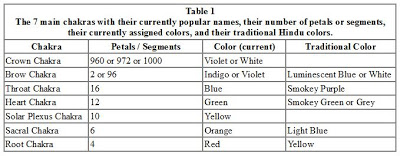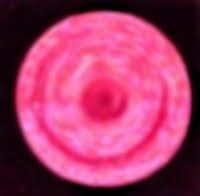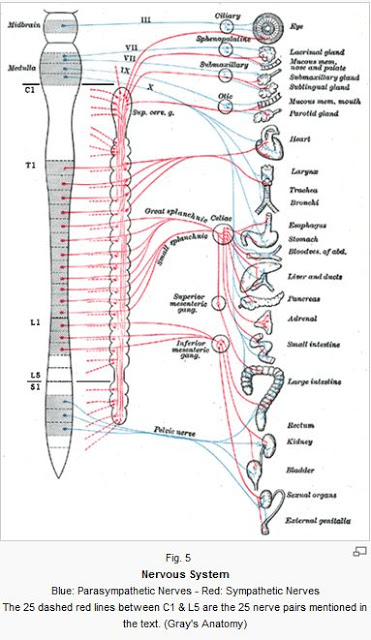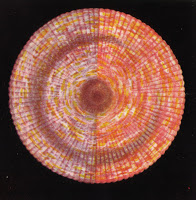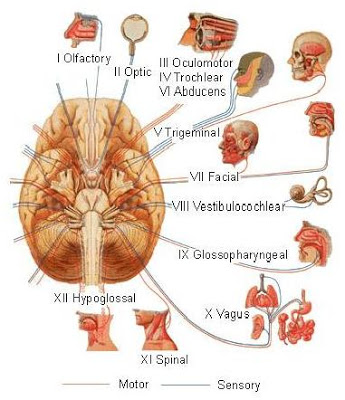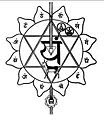The Chakras and their Petals - A Technical Overview
Contents
- 1 1. Introduction
- 2 2. Overview of generally well-known Data
- 3 3. How many Chakras actually?
- 4 4. An additional eighth main Chakra?
- 5 5. The Number of Petals for each Chakra
- 6 6. Considerations affecting the Number of Chakra Petals
- 6.1 6.1 The Link between the lower Chakras and the Sympathetic Nerves
- 6.2 6.2 The Brow and Crown Chakras and their link to the Brain-Hemispheres, Pituitary and Pineal Glands
- 6.3 6.3 The Coccyx and Crown Chakras and their effect on Cerebro-Spinal Fluid in the Spine and the Brain Ventricles - Amrita Nadi
- 6.4 6.4 Cerebro-Spinal Fluid and Amrita Nadi
- 6.5 6.5 The Crown Chakra and the twelve Cranial Nerve Pairs
- 6.6 6.6 The significance of 'one thousand twenty four'
- 7 7. Additional Illustrations
- 8 8. Book and Website Links
- 9 9. Reference Literature
- 10 Source
1. Introduction
(This article was at some point submitted to and published in Wikipedia. It was subsequently decided to expand it and - upon request - to move it back from Wikipedia to this website.)
Based on Hindu religion, tradition and culture, and supported by ancient (800 BCE and on) Sanskrit literature from India, it is generally accepted by those who through their involvement in meditation, yoga, reiki, etc. have acquired a more oriental or alternative view on what the human being in essence is, that there are seven major chakras within the human aura - or to say it differently, "seven subtle energy centres within the etheric human bio-energy field." In the current literature that deals with the human aura and chakras, expressions like 'bio-energy field' and 'energy centres' are often used in conjunction with words like 'aura' and the Sanskrit term 'chakra'. (Fig. 1, 2 and 3.)
Much of this oriental knowledge was brought to the West in early 1900 CE by people such as Sir John Woodroffe and the founders of the Theosophical Society.
The purpose of this article is twofold:
- Its main purpose is not to provide 'yet another overview' of what chakras are, as there are many excellent writings on this already. But instead - as the reason why each chakra has a specific number of petals is not generally known - the main focus will be on the technical reasons why the chakras hold within themselves the specific number of petals that they are traditionally reported to contain.
- The secondary purpose of this article is the introduction and description of a little known chakra - the Coccyx chakra - it is situated below the root chakra.
This article, at this point, will not deal with the tradition that has assigned specific Sanskrit characters, animal symbols, sounds, etc. to each chakra and its individual petals. Again, there is excellent literature available that deals with that.
Note: Traditionally the names used to identify chakras come from Sanskrit, but there is a New Age consensus in the use of English names for the chakras. In this article I will mainly use the English nomenclature.
2. Overview of generally well-known Data
Please, don't hesitate to check these data even if you are familiar with them, especially the tables that show petal quantity, current color assignment, nerve pair distribution and spinal vertebrae allocation of the chakras. Certain details will be discussed in depth and the reason for some changes to currently unquestioned data or assumptions will be extensively dealt with.
3. How many Chakras actually?
I hold to the view that each individual 'nerve end' is actually not a 'final ending'. The way I see it is that each nerve end is actually the tiniest chakra radiating bio-energy. Clusters of these tiny chakric nerve ends form our nervous plexi (Fig. 8), and it is these nervous plexi that in yoga literature are identified as the major chakras. The subtle bio-energy that radiates from all the chakras together form our auric bio-energy field or aura. (Fig.3)
As said above, in yogic traditions, it is generally accepted that there are seven major chakras within the subtle human energy body or 'auric bio-energy field'.
The traditional seven main chakras listed from the top down:
It has to be noted that the earliest Sanskrit sources (the most ancient Upanishads) list only four chakras, while the Yogatattva Upanishad (sloka 83-101) lists just five as it describes them as being interrelated with the five elements: earth, water, fire, air, space.
Over time, less ancient sources have added two or three major chakras to the original list, while contemporary New Age writers have added a plethora of minor ones. In this article, one more (though lesser known) chakra will be introduced.
The following illustration (Fig. 4) shows the seven main chakras as seen and depicted (amongst others) by C.W. Leadbeater of the Theosophical Society.
4. An additional eighth main Chakra?
In general and starting from the Root chakra upwards, the usually reported petal count for the above listed chakras (also see Fig. 4) runs as follows:
4, 6, 10, 12, 16, 2 or 96, 1000
In order to help us discover and understand the mathematical rational behind the above sequence properly (as well as the various and sometimes varying chakra petal counts) one additional but lesser known chakra will be introduced.
4.1 Color
Before we do that though, let's get a little deeper into the color designations of the 7 main chakras. According to current New Age tradition and starting from the Root chakra, their colors are red, orange, yellow, green, blue, indigo and violet.
There is a problem with that though. Usually, when the color spectrum is discussed, one color tends to get overlooked, magenta. However in technical discussions on the use of colors for printing or electronic color displays, magenta (the one missing from the popular listing of rainbow colors) always turns up.
- Printing uses for its colors the primary subtractive pigmentation colors: magenta, yellow and cyan.
Red, green and blue are its secondary subtractive colors and are the result of mixing the primary subtractive ones. - Electronic LCD display (e.g. flat computer monitors) uses for its colors the secondary additive colors red, green and blue.
Magenta, yellow and cyan are its primary additive colors and result from the mix of the secondary additive ones.
It is curious that magenta seems to have escaped a designation in the sequence of the main chakras.
Could it be that there is a missing chakra that can be assigned that color?
4.2 Numbers
When we look at the sequence of petal numbers or segments at the beginning of this section 4, it is not hard to suppose and discover that that sequence would be more complete if it started with the number 2. If that were the case the sequence would be as follows:
- 2, 4, 6, 10
These numbers happen to be the first four prime numbers (1, 2, 3, 5) multiplied by two.
Noting the bolded number 2, could it be that there is a chakra with just two segments?
4.3 The Coccyx Chakra
It so happens that there is an additional (but lesser known and commonly not consciously experienced) chakra, it is just below the Root chakra, situated at the very end of the tailbone or coccyx. This chakra, the Coccyx chakra, has just two petals, and is characterized by two hues of the color magenta. Fig. 4a is an attempt to depict how this chakra is clairvoyantly seen.
This chakra can be observed as a formation with two horizontal segments or petals, but it can also be seen as showing a very dynamic rotating yin/yang-like formation.
Where the Crown chakra is related to the spiritual energies of the universe as a whole, the Coccyx chakra is related to the physical energies of the universe as a whole. Interestingly the Crown and Coccyx chakras are also directly connected to each other, compare this to the Ouroboros snake eating its tail. This connection is necessarily so, as the universe is an integrated whole.
Just like the five chakras higher up, the Coccyx chakra is also related to an 'element', but one that is not usually identified as one: the 'strong nuclear force-field', an 'elemental aggregation dynamic' that by means of gluons transmits the strong nuclear force - the interaction that holds each individual proton and neutron together, but also keeps the neutrons and protons together in a tight bond to form the nucleus of atoms.
Of course the solidity of this 'strong force aggregate' is even more solid than the 'earth' element.
5. The Number of Petals for each Chakra
The relationship between the number of chakra petals and the human body is much more fundamental - physically concrete - than it is generally assumed to be. Often only a symbolic meaning is given to the petal counts, especially when discussed in relation to the Sanskrit characters that are traditionally assigned to the chakras and their petals.
It will become evident in this article that the petal count for each chakra is related to certain specific groupings of vertebrae and certain specific groupings of nerve pairs in the peripheral nervous system (PNS) that emanate from the spinal column through the vertebrae.
Early yogic investigators of the chakras (who either depicted or enumerated the chakra petals) were not only intuitive or clairvoyant but also used anatomical practices to find a correlation between what they saw intuitively, and what they discovered through their physical anatomical research. Terms like sushumna, ida and pingala that often appear in texts dealing with yoga, chakras or kundalini are not only dealing with esoteric subtle energy notions, but also point concretely at physical structures found in the human body in a spectrum ranging from the more physical or gross to the more spiritual or subtle.
6. Considerations affecting the Number of Chakra Petals
6.1 The Link between the lower Chakras and the Sympathetic Nerves
As previously stated, the main purpose of this article is to show how the number of chakra petals is not just 'some number' but rather that that number is specifically related to and depending on a series of physical internal components within the human body, e.g. its skeletal and peripheral nervous system parts as well as some specific physical structures within the brain.
- Traditional groupings of spinal vertebrae.
Fig. 5, left section, the white and gray areas: the spinal column.
C1 - C7 (cranial), T1 - T12 (thorax), L1 - L5 (lumbar), S1 - S5 (sacral) - Groupings of nerve pairs in the autonomic nervous system serving the various organs and glands.
Fig. 5, middle section: red dotted lines connecting to grouped solid red lines. - The pituitary and pineal glands situated within the brain. Fig. 9.
- The two hemispheres of the brain. Fig. 11.
- The meninges around, and the ventricles within the brain containing cerebral spinal fluid (CFS). Figs. 12 and 13.
- The 12 cranial nerve pairs. Fig. 15.
A clairvoyant observer envisages chakras as energy fields that resemble rotating color wheels, (fig. 4) somewhat funnel or vortex-like. They may look like segmented wheels, as they seem to be separated by a number of spokes. "The Chakras" by Leadbeater is considered to be a classic book on this topic. In it, the chakras are depicted as segmented, spoked or striated color wheels, the segments of which, according to tradition, are called petals. Leadbeater identifies a bottom-of-a-basket weave pattern to the arrangement of a chakra's petals, he also identifies their energetic dynamic flow as in terms of 'undulations'. Thus, appellations such as 'colored undulations', 'striated rotating energy disks' or 'circular concentric interference wave patterns' describe the way these segmented chakras are seen by clairvoyants much more accurately than the word 'petals'.
Except for the Crown chakra, literature in general agrees on the number of petals or segments for each chakra. In her book "Wheels of Life" Anodea Judith lists the following for the number of Crown chakra (Sahasrara) petals:
- "Some say 960, some say 1,000 [...] 960 is the mathematical equivalent of the first five chakras together (4+6+10+12+16) multiplied by the two petals of chakra six, times ten."
In addition to explaining the reason for the specific number of petals that each chakra can be observed to contain, this article also addresses the reason for the discrepancy between the number of petals for the Crown chakra as reported in various differing older ("The Chakras", 1927) and newer ("Wheels of Life", 1999) writings, e.g. 960/972 vs. 1,000.
In order to understand this discrepancy, it will prove to be worthwhile to recognize the earlier mentioned additional chakra, the Coccyx chakra. I introduced that chakra for the first time in 1999 during a speaking-engagement, in a handout titled "Chakras: A Clearer View." In the handout I indicated that this chakra is situated just below the Root chakra at the tip of the coccyx. It is linked to the 'filum terminale' nerve. (See the small nrs. 5 and 6 in fig. 6.)
When this additional chakra is taken into account, the reason for the difference between the Crown chakra petal counts of 960 vs 1,000 will be become clear. This will be discussed in detail in the text following the table below.
Generally, and as listed already above, the petal counts runs from 4 to 6 then 10, 12, 16, 96 and 1000.
In his book "The Chakras", Leadbeater shows an illustration in which the five lower chakras are related to various nervous plexi that are part of the central nervous system. (Fig. 8)
Keeping that in mind, we can - for the six lower chakras - come to an understanding of the relationship between:
- the number of petals, segments or undulations of those chakras,
- the number of vertebrae that each particular chakra appears to be linked to,
- the number of nerves (in pairs) emanating from the particular groupings of vertebrae.
In my handout "The Chakras, A Clearer View", I described that according to traditional descriptions the human spine consists of 24 vertebrae and that 24 nerve pairs (48 nerves) emanate from those 24 vertebrae. I also described that in modern anatomy it is observed that 25 nerve pairs are found instead of 24. The difference between the older count (24 nerve pairs) and the current count (25 nerve pairs) might very well explain the discrepancy in the crown chakra's numbers of petals that are either reported as being 960 or 1000. This will be covered again in more detail later on.
When the number of petals of the five commonly accepted lower chakras (not including the extra Coccyx chakra) are added up, one comes to a total of 48 petals (4+6+10+12+16=48). It is interesting that this number corresponds to the 48 nerves as they are identified in older anatomy sources. When the Coccyx chakra (consisting of two petals) is included, one counts 50 petals. This quantity corresponds to the current count of 50 nerves, the 25 nerve pairs that emanate from the spinal vertebrae.
The six lower chakras thus appear to be directly related to the nerve pairs that emanate from the spinal column. Their petal count corresponds - although not exactly - to the current convention of anatomical identification and numbering of the vertebrae and nerve pairs:
The arrangement for the chakras - but now including the additional Coccyx chakra - that are directly related to the vertebrae and their CNS nerve pairs, is as follows:
When we look at an anatomy chart (usually displayed on a wall in a doctor's or chiropractor's office) depicting the vertebrae and their nerve pairs, it can be demonstrated that the division as described in the list above makes as much sense (or more) as the current convention of vertebrae number designation.
6.2 The Brow and Crown Chakras and their link to the Brain-Hemispheres, Pituitary and Pineal Glands
Whereas the lower chakras are directly related to the spine, it should be noted that the Brow and Crown chakras do not have a spinal column connection. Instead, according to most literature, they are directly linked to two glands embedded in the human brain: the pituitary gland (hypophysis) and the pineal gland (epiphysis). (Fig. 9)
The Brow chakra is linked to the pituitary gland which consists of two parts, the anterior and the posterior lobes. This two lobed feature of the pituitary gland - or alternatively - the two hemispheres of the brain (which this chakra is also reported to be influenced by) may account for the fact that in many illustrations the Brow chakra is depicted containing two large petals instead of 96. (Fig. 10, 10a and 11.)
In my view it is this two-fold nature of the brain that accounts for the doubling of the total number of petals of the traditional five lower chakras, as their accumulated energy reaches the Brow chakra thus producing the traditional 96 (2x48) petals of the Brow chakra. This is clearly depicted by Leadbeater: two vertical semi-circles containing 48 striations or undulations each, adding up to 96 petals altogether. (Fig. 10a)
We can thus conclude that some 'yogis-of-old' had found that the human body contained 24 spinal nerve pairs that were intricately connected to the brain's two hemispheres, thus showing up as 960 petals in their depictions and descriptions of the Crown chakra: 2x48x10=960.
Some other 'yogis-of-old' must have known, as we know now, that there were 25 nerve pairs involved, hence 2x50x10, or one thousand petals for the Crown chakra. (Fig.12)
No wonder this chakra is also called:
"The Thousand Petaled Lotus"
In most chakra literature, chakras are described as subtle energy centres processing and transmitting subtle vibrational energies. The chakra pictures found in Leadbeater's "The Chakras" show this vibrational energy as concentric undulations or interwoven energy waves. Keeping that in the mind's eye, one can envisage that the energetic wave packets, as they acquire and build up more energy while moving up from the lower chakras up the spinal chord to the highest chakra, that they affect the total energy of the Crown chakra around or, according to most writings, above the head - but still within the subtle energy field that surrounds the human body.
6.3 The Coccyx and Crown Chakras and their effect on Cerebro-Spinal Fluid in the Spine and the Brain Ventricles - Amrita Nadi
The brain contains within it a number of cerebro-spinal fluid (CFS) containing cavities - the brain's ventricles. (Figs. 13 and 14.) They contain the same fluid that flows through the spine's inner core as well as through the meninges around the brain.
Using a specific subtle pumping mechanism (which is described in a separate blog entry) this cerebro-spinal fluid circulates from the tip of the spine (location of the Coccyx Chakra) to the top of the head (location of the Crown Chakra) through:
- the central spinal canal,
- the outermost layer of the spinal chord,
- the meninges that surround the brain,
- the ventricles inside the brain.
6.4 Cerebro-Spinal Fluid and Amrita Nadi
This cerebro-spinal fluid (according to current histology texts) leaks out from the ventricles and the spinal chord, either to be absorbed by the blood or to 'bathe' the nerves by a process that is still not well understood.
The combined vibrational energy from the seven chakras (50 petals) below the Crown chakra may well get its vibrational strength multiplied ten-fold by means of the CSF filled ventricles (it is not clear yet though what the dynamics are behind this ten-foldness) thus producing the 1000 (2x50x10) petals as they can be observed in the crown chakra.
In ancient yoga literature (Hatha Yoga Pradipika) this fluid, when energized through specific yogic practices or under the influence of the Kundalini Process, is identified as Amrita, Soma or Nectar, the energetic channel through which it circulates is called Amrita Nadi.
6.5 The Crown Chakra and the twelve Cranial Nerve Pairs
The Crown chakra can be observed clairvoyantly (see the centre of fig. 12) with an additional twelve double-lobed flower-like formation at its centre. This accounts for Leadbeater's additional 12 petals which, when added to his 960, make up the 972 petals that the crown chakra is reported to contain by him. In turn this central flower figure contains another striated circular formation. But as we have already seen, Leadbeater's count is not totally correct.
Leadbeater did not observe the double lobed nature of this central 12 petal flower-like figure. It represents the 12 cranial nerve pairs that are found to exist within the human brain (Fig. 15). When we convert the updated nerve count into an updated petal count we come to a total number of 1024 petals.
6.6 The significance of 'one thousand twenty four'
In tables 1, 3, 4 and the above sub-sections, it was shown and discussed that the total number of chakra petals as related to the main nerve pairs plus the coccygeal nerve pair is 1000 and when we add the 12 cranial nerve pairs we get to a total of 1024.
'One thousand twenty four... That is a very interesting number as it shows up in the string of numbers: 1, 2, 4, 8, 16, 32. 64, 128, 256, 512, 1024, etc.
In my view this sequence is connected to the cell division just after fertilization of the female ovum. The embryonic cells multiply exactly according to that sequence. It may well be possible that each one of those earliest 1024 cells already contain a proto-structure that in its fully developed form is still present as the main nerves of our nervous system and is also represented by the subtle energies that are active in all the chakras culminating in the 'glory' of the Crown chakra.
7. Additional Illustrations
8. Book and Website Links
- The Chakras, Charles Leadbeater (1927)
http://www.amazon.com/Chakras-Quest-Book-Charles-Leadbeater/dp/0835604225/ref=sr_1_1?ie=UTF8&s=books&qid=1257208820&sr=8-1 - Chakras, Energy Centers of Transformation, Harish Johari (1987).
http://www.amazon.com/Chakras-Centers-Transformation-Harish-Johari/dp/0892817607/ref=sr_1_1?ie=UTF8&s=books&qid=1257209168&sr=8-1 - Web link (Good traditional source overall, note the section on kanda & cauda equina/filum terminale)
http://www.yoga-age.com/modern/kun4.html
9. Reference Literature
- Judith, Anodea (1999). Wheels of Life: A User's Guide to the Chakra System. Llewellyn Worldwide. ISBN 0875423205.
- Borsboom, Wim (1999). The Chakras: A Clearer View. Victoria, Canada: AuraSphere Unlimited Living.
- W.M. Copenhaver PH.D, R.P Bunge PH.D, M.B. Bunge PH.D (1964). Bailey's Textbook Of Histology. Baltimore, Md, USA: The Williams & Wilkins Company. ISBN 683-02073-0.
- Dixon, Jana (2008) Biology of Kundalini, Lulu.com; ISBN-10: 143571167X, ISBN-13: 978-1435711679
- Johari, Harish (1987). Chakras: Energy Centers of Transformation. Rochester, Vermont: Destiny Books. ISBN 0-89281-054-8.
- Leadbeater, C.W. (1927). The Chakras. Adyar, Madras, India: The Theosophical Publishing House. ISBN 0-8356-7016-3.
- Prophet, Elizabeth Clare (2000). Your Seven Energy Centers: A Holistic Approach To Physical, Emotional And Spiritual Vitality. Summit University Press. ISBN 978-0922729562.
- Stein, Diane (1995). Essential Reiki: A Complete Guide to an Ancient Healing Art. Berkeley, USA: Crossing Press. ISBN 978-0895947369.
- Satyananda, Swami Saraswati (1984). Kundalini Tantra. Bihar, India: Bihar School of Yoga.
- Woodroffe, Sir John (1919 - 1964). The Serpent Power. Madras, India: Ganesh & Co. ISBN 0-486-23058-9.
Source
thekundaliniprocess.blogspot.com.au

